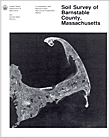The following is a map unit description from the "Soil Survey of Barnstable County, Massachusetts (Fletcher, 1993)"

PeA-Pipestone loamy coarse sand, 0 to 3 percent slopes. This very deep, nearly level, poorly drained soil is in depressions, at the base of swales, and in low areas bordering streams, ponds, and swamps. It is on outwash plains and in areas of glacial lake deposits. It makes up about 0.3 percent (753 acres) of the survey area. It is mapped throughout the county. Areas are irregular in shape and range from 5 to 75 acres in size.
Typically, the surface is covered with an organic layer. This layer is about 1 inch of loose, undecomposed pine needles, leaves, and twigs and 3 inches of partly decomposed and well decomposed organic material. The surface layer is about 15 inches thick. It is black, very friable loamy coarse sand in the upper 2 inches and light brownish gray, mottled, loose coarse sand in the lower 13 inches. The subsoil is about 19 inches thick. It is mottled throughout. The upper 1 inch is dark reddish brown, very friable loamy coarse sand; the next 4 inches is dark brown, firm coarse sand; and the lower 14 inches is yellowish brown, loose coarse sand. The upper 14 inches of the substratum is brown, loose very gravelly coarse sand. The lower part to a depth of 65 inches or more is grayish brown, loose coarse sand.
Included with this soil in mapping are small areas of Berryland, Deerfield, and Walpole soils. Also included are areas where the soil shows no evidence of profile development and does not have an organic layer on the surface. Included soils make up about 30 percent of this unit.
Permeability is rapid throughout the Pipestone soil. Available water capacity is low. Depth to the seasonal high water table is 0.5 foot to 1.5 feet in fall, winter, and spring and after periods of heavy precipitation.
Most areas are used as woodland or support shrubby vegetation.
This soil is poorly suited to many of the crops commonly grown in the county. Wetness is a major management concern. Droughtiness during dry periods is an additional concern. Drainage and irrigation systems are needed for good yields. Growing cover crops, incorporating grasses and legumes into the crop rotation, and mixing manure and crop residue into the plow layer improve tilth.
This soil is poorly suited to hay and pasture. Watertolerant grasses and legumes should be selected for planting. The main management concern is the prevention of overgrazing, which reduces the hardiness and density of desirable plants. Proper stocking rates, timely grazing, and restricted use during wet periods help to maintain plant density and minimize surface compaction.
This soil is suited to woodland. Poor drainage is the main management concern. Equipment can become mired when the soil is wet. Thinning dense stands to standard stocking levels results in more vigorous tree growth. The most common trees are pitch pine and red maple.
The seasonal high water table is a limitation if this soil is used as a site for dwellings with or without basements or as a site for septic tank absorption fields. The rapid permeability also is a limitation on sites for septic tank absorption fields. The soil may not adequately filter the effluent. The poor filtering capacity may result in the pollution of ground water. Alternative sites should be selected.